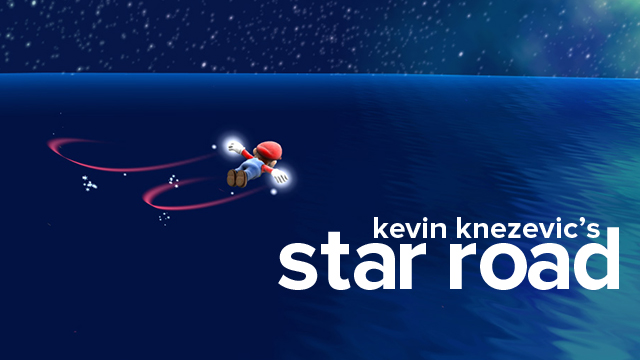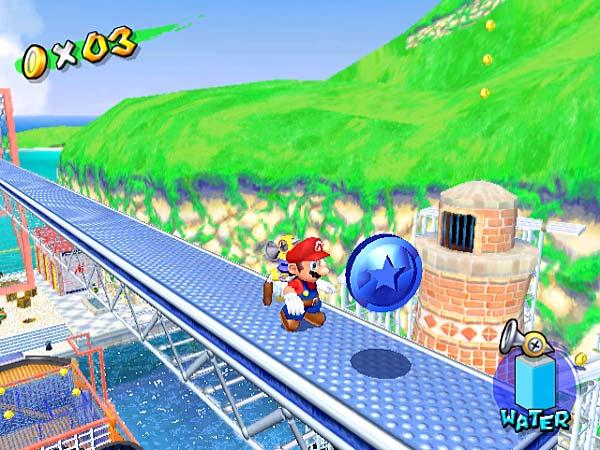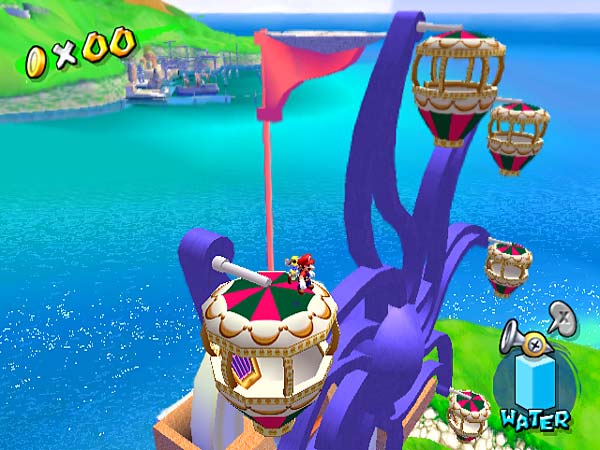
Even among the Mario faithful, Super Mario Sunshine is widely considered to be something of a disappointment. While the title didn’t do anything particularly wrong (though its unified setting certainly didn’t sit well with many people at the time), its general lack of ambition, coupled with years of fan expectations, created a level of hype that the game couldn’t possibly meet.
It’s hard not to sympathize with this view of the game, especially when you consider the legacy that the Mario series had built. The very first Super Mario Bros. effectively created the side-scrolling platformer, freeing video games from the confines of a static screen and turning the NES into a cultural phenomenon. Super Mario Bros. 3 improved upon its predecessor in every way imaginable, adding new power-ups, more varied levels, mini-games, an inventory system, and even an overworld to its gameplay. Super Mario World refined 3’s innovations and introduced branching pathways into its design, adding an element of exploration to the game (not to mention demonstrating the graphical prowess of the Super NES). And Super Mario 64 brought the franchise into three-dimensions, reinventing the classic Mario gameplay and laying down the foundation for all 3D games that were to follow. With such an impressive pedigree behind it, it was only natural that fans would expect a lot from Mario’s GameCube debut.
It should be no surprise, then, that what we ultimately got was dismissed as a simple retread of Mario 64, a tropical-themed expansion that did little to press the series forward, and even less to attract new gamers to the struggling console. The intervening years between 64 and Sunshine (not to mention the persistent rumors of a Super Mario 64 2 being in the works, despite how unsubstantiated they might have been) had caused fan expectations to rise beyond control, and anything less than a complete revolution was going to come as a disappointment to them. Fun as Sunshine may have been (and it certainly was, as I’ll hope to articulate), it failed to match the impressive strides that its forebears had made, and for that it was roundly criticized.
Of course, it’s only with the benefit of hindsight that we can see how innovative Super Mario Sunshine really was. It’s true that the game bears more than a passing resemblance to Super Mario 64, but like Mario World before it, Sunshine takes the innovations pioneered by that title and refines them even further, throwing in its own unique gameplay ideas for good measure. Levels were far more expansive than anything found in Mario’s N64 adventure, and they even incorporated some older Mario elements, like flip-gates and smashable blocks, that had fallen by the wayside when the series made the transition to 3D. Likewise, the controls were tightened up considerably in the move to GameCube, with the plumber’s new water pack, F.L.U.D.D., lending an unprecedented degree of precision to the platforming.

More than anything, though, Sunshine marked the definitive midpoint between Super Mario 64 and Super Mario Galaxy, both in terms of its chronological placement in the series and in its approach to game design. Levels were laid out in a similar fashion to the ones in 64, with eight different objectives spread out amongst their boundaries, but each was now peppered with a handful of “secret” stages that helped punctuate the gameplay with some much-needed action. Here Mario would have to brave the intense platforming challenges laid before him without the aid of his water pack, relying on nothing but deft skill and quick reflex to conquer their obstacles. These areas were certainly a far cry from the serene pace of Sunshine’s “proper” stages, and their inclusion helped distance the game from its 64-bit predecessor and gave it an identity all its own.
In fact, these levels were perhaps Sunshine’s greatest contribution to the Mario series, as they effectively paved the way for the Galaxy titles that were to follow. Unlike the other locales that Mario had to explore, the secret stages in Sunshine hearkened back to the plumber’s early days of platforming. Unadorned by any of the scenic trappings that made up the rest of Isle Delfino, these levels were more akin to straightforward obstacle courses in their construction, with hazards that could only be bested by your platforming acumen (and sheer determination, as some of them were quite devious in their design). They also happened to be the most lauded aspect of the game, so much so that many reviewers of the time, in a bit of unwitting clairvoyance, even said that they would be willing to play a Mario title comprised entirely of these stages.
That, as it turned out, would not be far off the mark, as Mario’s next adventure, Super Mario Galaxy, would use these secret stages as the foundation for its own gameplay. Like them, Super Mario Galaxy stripped away the open worlds of 64 for a more focused set of challenges. Levels were decidedly more linear than they were in any previous 3D Mario game, emphasizing reflex more than item collection, and bringing the series closer to its platforming roots than it had ever been since making the jump to three-dimensions. Indeed, it’s no stretch to say that the Galaxy titles (and even Super Mario 3D Land, which also took a more straightforward approach to its level design) owe their very existence to Sunshine, and Galaxy 2 even pays homage to the game by including one of these stages wholesale in its special world.

Still, even if the rest of the adventure wasn’t quite as influential on the future of the Mario series as this particular element, Sunshine was nevertheless an enjoyable iteration on the Super Mario 64 gameplay. The game’s tropical motif, which many felt stifled the creativity of the level design, actually helped ground the adventure in a sense of place. Mario may not have been able to explore the range of climes that he was normally accustomed to, but within the context of their setting, the levels that he did traverse were all distinct and varied, tied together by the most charming hub area this side of Peach’s castle. And even when the stages did bleed together in terms of their look, each was unique enough to stand out among the others, from the cold, conch-like structures of Noki Bay to the quiet serenity of Sirena Beach.
If anything, this adherence to a specific theme helped encourage players to explore Isle Delfino, as it really did feel like the video game equivalent of a tropical vacation. Unlike the more nebulous levels of Mario 64, which were designed foremost to facilitate platforming, Sunshine took a page out of Rare’s book (specifically the one it consulted when developing Banjo-Kazooie) and placed a greater emphasis on world construction. Each stage now felt like a genuine locale, complete with unique landmarks and terrain, inviting players to take in the sights and sounds of the island around them. Even if you weren’t particularly satisfied with the game’s direction, it was hard not to be charmed by the clear blue skies and crystalline waves that caressed its levels. And that’s nothing to say of the Calypso-flavored soundtrack, which only reinforced the vacation feel that permeated the adventure.
So while Super Mario Sunshine may not have been the radical leap forward that fans of Super Mario 64 were expecting, it was still another fine addition to the storied franchise. Not only did it give gamers one of the most charming virtual worlds to play around in, but it also sowed the seeds for Mario’s future adventures, capturing the 2D spirit that was lost in his move to three-dimensions. Perhaps now, a decade removed from the initial stigma that surrounded its release, the game can finally take its place among Nintendo’s more notable titles, if not as another Mario classic, then at least as a harbinger of greater things still to come for the series.




 ShareThis
ShareThis







Great article, Kevin! I think Sunshine is mostly overlooked due to something you pointed out – it didn’t take as huge of a step forward as Super Mario 64 did. If we look at the context of both games’ release, we see that, prior to SM64, there were no 3D Mario’s. I mean, Mario making the jump from 2D to 3D was a huge milestone. The innovation in Sunshine, however, didn’t come from a graphical enhancements, but rather in the form of gameplay mechanics. Mechanics are far less noticeable to the mainstream than graphics.
In truth, though, I actually liked Sunshine far more than SM64, and actually consider it on-par with the original Super Mario Galaxy. I find the gameplay to be absolutely enthralling and simply fun.
Thanks, Bradly!
I don’t think I like Mario Sunshine quite as much as you do (I’d still say it’s my least favorite of the 3D Mario games despite how much I enjoyed it), but the game is certainly much better than most people make it out to be!
The tropical island theme is probably the biggest reason I purchased this game in the first place. It was so different yet familiar.
I’m a big fan of the setting, too. It may not have been quite as imaginative as some of the ones in Mario 64 or Mario Galaxy, but it was very well-realized and added an exotic charm to the game. :)
One of the biggest reasons why Sunshine does not fit into the Mario canon receives absolutely zero mention here.
Mario -wore- his power-up, he didn’t -become- it.
This, simply put, was not a Mario game. Any Dick, Joe, or Harry could have put on Fludd, and, guess what, they would’ve fit into that world just as well as Mario did.
Everything from the Fire Flower in Super Mario Bros. to the Tanooki Suit in Super Mario Bros. 3 to Metal Mario in Super Mario 64 – the power-ups that gave Mario his strength were power-ups that directly changed his very character.
Mario didn’t feel like a plumber who just happened to be extremely nimble and could make the most of his surrounding (re: that’s not really Mario – that’s -you-), he felt like a Janitor that decided to bring his vacuum clea . . . sorry, that’s Luigi, on his vacation.
Kevin is correct in stating that the locale was a bit of a shrug, especially seeing that this one locale, repeated and re-chewed for all the levels, would have simply comprised of one world in a game of eight worlds, or fifteen lands in previous titles. The theme got boring, and pretty quickly.
But that water pack. Worst. Idea. Ever. It made it feel as if Mario shouldn’t even be making those jumps – as if he’s out of place in his own game – and even worse, that it’s not Mario solving the problems or beating the bad-guys.
I’m not going to say this game was a flop – because that it wasn’t. But it doesn’t even qualify as a black sheep – it simply doesn’t fit into the family.
It may have been my placement in terms of the Mario chronology but I’ve always had very warm memories of Sunshine. (Maybe we just don’t get much of it in Scotland? Hah.) I wasn’t around for the initial release of Super Mario 64 or even Ocarina so the likes of Sunshine and Wind Waker were my inauguration into these classic franchises and they’ll always hold special memories for me because of that.
However more than that, I believe Sunshine was an incredibly accomplished game. Much like Wind Waker, the sense of place is incredibly strong and vivid and succeeds in creating the connected world you discuss, Kevin. It was also damn hard for your first Mario adventure, to the point that I still haven’t defeated Bowser…
It might not have been as revolutionary as Galaxy but Sunshine had a lot to offer, most of which is often underappreciated perhaps. The technical precision (error in this game always felt like a failure of the player and not the controls despite the vast abilities of FLUDD) the inherently political atmosphere of the narrative, the scope of the challenges; Sunshine was a great game, without question.